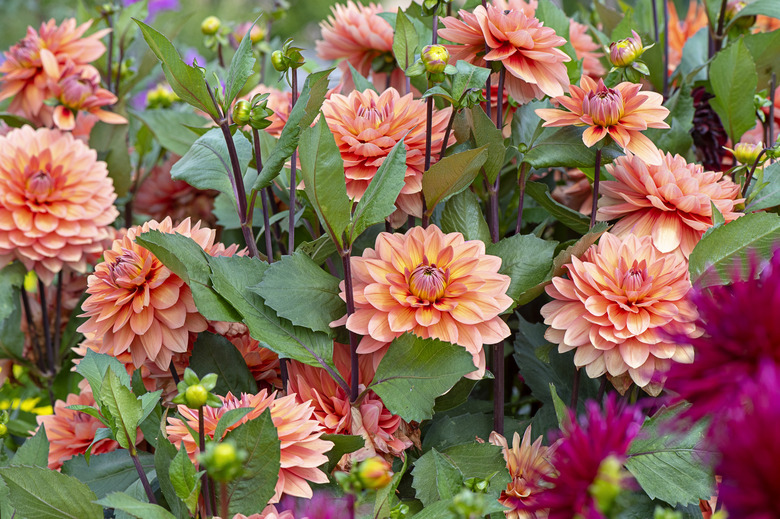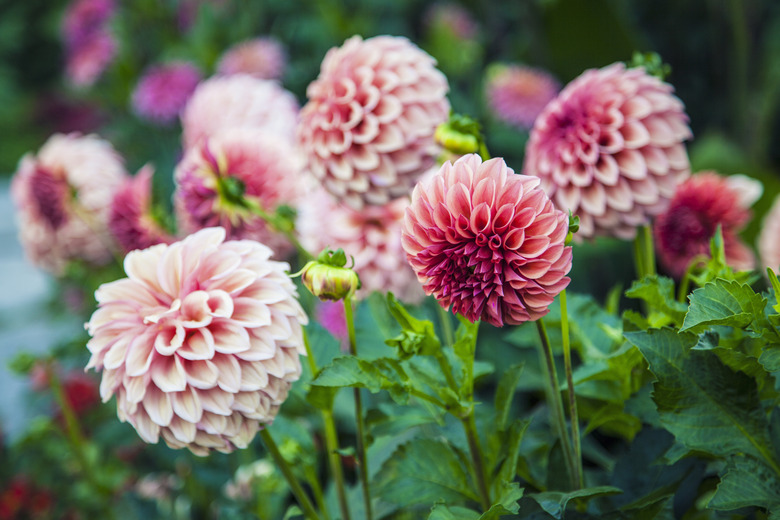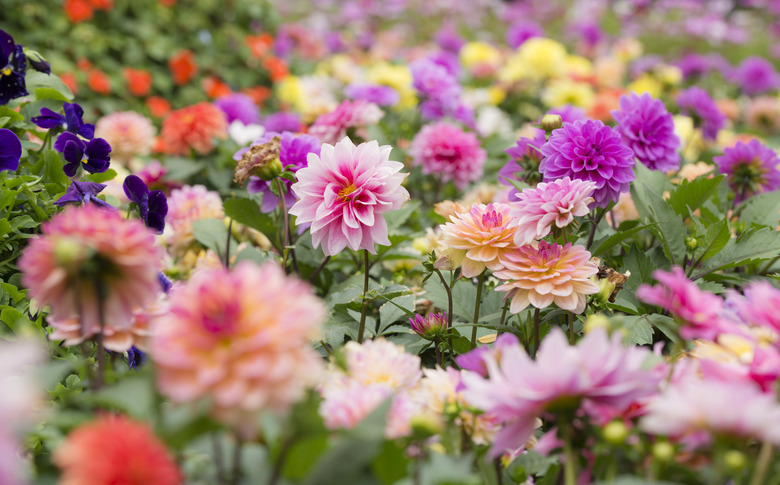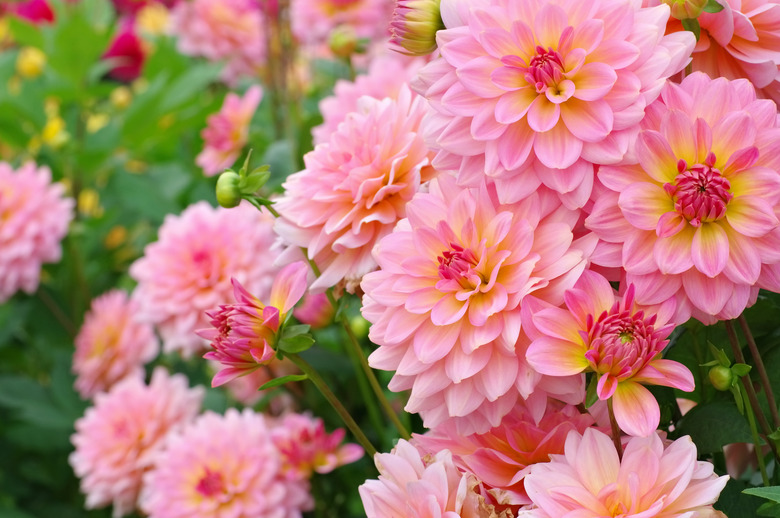How To Grow Dahlias
We may receive a commission on purchases made from links.
When other summer flowers are passing the peak of their seasonal performance, dahlias (Dahlia spp.) turn up the volume with their dazzling late-season display. Although they'll start blooming in midsummer, dahlia flowers really come into their own during late summer and fall. From dwarf types of only 12 inches tall to magnificent giants of 6 feet, dahlia plants also display a stunning array of flower shapes, colors and sizes, from 1-inch cuties to impressive blooms up to 14 inches in diameter called "dinner plate" flowers.
Although there are more than 40 dahlia species, all modern-day garden dahlias are hybrids, which are not classified by species but rather are divided into groups that categorize flowers by size, form and color.
Dahlias are herbaceous perennials in U.S. Department of Agriculture plant hardiness zones 7 through 10, but gardeners in zones outside this perennial range can grow them as annuals. As an option, gardeners who live outside this plant's cold-hardy range can store their dahlia tubers indoors over winter from year to year to enjoy many repeat performances of their favorite flowers. Sprouting from tubers that resemble small sweet potatoes, dahlias can be grown as in-ground or container plants. Although growing dahlias may require a little more attention than growing other types of plants, die-hard fans of these lovely flowers know that the payoff is worth a little extra care.
Best Uses for Dahlias
Best Uses for Dahlias
Dahlias are versatile landscape performers, as comfortable in a sunny border garden as they are in containers. They add a dramatic touch to the landscape, particularly the tall-growing, large-flowering types. For the best effect, plant landscape dahlias in groups of a minimum of five plants. Regularly deadhead the spent blooms to encourage plants to set more flower buds.
Regardless of their size, dahlias also make lovely cut flowers. Cut the blooms early in the morning and immediately place the stems in warm water. One tip for cutting dahlia flowers is to wait until they've fully opened because they will not continue to open after they've been cut.
How to Grow Dahlias
How to Grow Dahlias
Dahlias are most commonly started from tubers, and you can plant them as early as about two weeks before the last spring frost in loose, well-draining garden soil that's rich in organic matter, spacing tubers 18 to 30 inches apart depending on the mature size of the cultivar. Plant tubers of tall dahlia cultivars about 6 inches deep (shorter types about 3 inches deep) by laying single tubers on their side. If you have a clump of tubers, spread out all the tubers attached to the dormant stem like spokes on a wheel before placing in the planting hole.
After covering dahlia tubers with soil, go ahead and place plant stakes or a tomato cage around each tall cultivar to help support its growth. Staking dahlias helps support their growth so the stems don't fall over and potentially break under the weight of flowers. The stems will not naturally cling to or twine around a vertical structure, which means you'll have to tie the stems to their support as they grow. Instead of using garden twine, which can cut into the stems, use sections of nylon stockings or another type of soft and stretchy fabric to secure the stems by gently tying them to the support.
In What Zone Do Dahlias Grow Best?
In What Zone Do Dahlias Grow Best?
Although dahlias are winter-hardy in zones 7 through 10, the temperatures in some zone 7 microclimates may only marginally protect the tubers in winter. Even in zone 8a, which averages 10 degrees colder than zone 8b in winter, there's the possibility that tubers may suffer injury from unseasonably cold weather. To mitigate the risk to tubers, gardeners in the coldest zones of dahlia's hardiness range may want to dig them in fall and overwinter them indoors.
When Should You Plant Dahlias?
When Should You Plant Dahlias?
Even though you can plant dahlia tubers up to two weeks before the expected last spring frost, you may want to wait until after the last frost to plant them. There's always a chance of an unexpected late frost, which will burn any stems that have sprouted above the soil. The tubers will send up more growth, but the frost damage will delay the time to maturity and, therefore, delay the onset of flowers.
To be on the safe side, you can start the tubers in pots indoors and transplant them a week or two after the last frost. Because you'll plant tubers horizontally, choose a wide pot, such as a mum pot, to accommodate the length of the tubers. If you try to squeeze the tubers into a pot that's too narrow, you may damage the eye at one end of the tuber, which is where the stem will sprout.
Soil, Sunlight, and Water Recommendations
Soil, Sunlight, and Water Recommendations
The optimal soil for growing dahlias is loose, nutrient-rich and well-draining. Unfortunately, this combination doesn't exist in most gardens, but native soil can be amended to maximize its effectiveness. Before planting dahlias, incorporate organic matter, such as well-aged manures, compost and/or decomposed leaf mold into the top 8 inches of soil at the rate of about 1/3 amendments to 2/3 native soil.
Dahlias grow best in full sun, but they'll appreciate a little afternoon shade or filtered sun in hot climates. If you give them too much shade, however, their long stems may become too leggy from stretching to find enough sunlight. Heavy blooms from large-flowered cultivars may bow these leggy stems.
Water dahlias by soaking deeply once a week instead of making frequent light sprinklings. Plants prefer moist but not soggy soil, and adding a layer of mulch around plants will help the soil retain its moisture. If you skip the mulch, you may have to water your plants twice a week during hot, dry intervals.
When fertilizing dahlias, add the product regularly during the growing season instead of giving plants a big jolt at the beginning of the season. If you use well-aged manure to amend the soil, you won't have to add fertilizer when you plant dahlia tubers. If you didn't incorporate organic matter before planting, add a balanced fertilizer, such as 8-8-8 or an organic equivalent, at the rate of 1/8 cup per plant around young plants. When large plants reach 5 feet in height, give them 1/2 cup of the same type of fertilizer each month until August, at which time you'll stop fertilizing your dahlias.
How to Propagate Dahlias
How to Propagate Dahlias
At the end of the growing season but before the first frost, particularly if you live outside dahlia's hardiness range, you can dig and divide the tubers. If you plant a single tuber in spring, it will form a clump of tubers by the end of the season. Here's how to propagate dahlias:
- Separate dahlia clumps by dividing them into individual tubers, each
of which has an "eye" at the narrow end; this is where the stem will form. - You
can divide dahlia clumps when you dig them in fall, or you can store the entire
clump over winter and divide into individual tubers the following spring before
you plant them. - Sanitize a knife, garden shears, or other cutting tool with a solution that's at least 70 percent ethanol or isopropyl alcohol.
- Wipe the blades with the solution or dip the blades in the solution before each cut to help prevent the spread of disease.
How to Winterize Dahlias
How to Winterize Dahlias
Even gardeners who grow dahlias in this plant's hardiness range faithfully dig, divide and overwinter the tubers each year. When done properly, this process can enhance a plant's blooming potential and overall performance. After digging the tubers in fall, let them dry in the shade (or indoors) for a day or two. Brush off the soil from around the tubers and dust the tubers with a fungicide.
When overwintering dahlias, store the tubers in a cool, dark place. Without touching each other, place the tubers in paper bags, paper boxes or mesh bags filled with slightly damp peat moss or vermiculite. Storing in wet peat moss and/or unvented plastic bags may cause the tubers to rot.
Common Pests and Other Problems
Common Pests and Other Problems
Aphids, leafhoppers, and spider mites are common pests for dahlias. Use an insecticidal soap to control these pests. If you see large holes eaten in the leaves and slime trails on your plants, slugs are the culprit. You won't likely see them feeding on your plants because they generally do their damage at night. Sprinkle cornmeal or diatomaceous earth around your plants to control slugs.
Warning
Although dahlia has a low poison threshold, it can be toxic to people, cats, dogs, and horses if eaten in large amounts. Some gardeners have a problem with skin irritation from contact dermatitis, so it's best to handle plants and tubers while wearing gardening gloves.
Common Diseases
Common Diseases
Powdery mildew can be a problem for dahlias. This fungal disease is caused by different pathogens, all of which leave the same telltale symptom — a white, powdery substance on the upper surfaces of leaves. The best plan of attack is prevention. Avoid overhead irrigation from sprinklers, space plants so that air freely circulates around them and make sure plants receive plenty of sun.
Too much water or soil that drains poorly can cause the tubers to rot and plants to wilt. This is another fungal problem that is best approached by prevention. Plant dahlias on loose, well-draining soil.
Using raised beds and large containers (at least 15 inches in diameter), both of which generally have better drainage than in-ground soil, is another strategy to keep the tubers from sitting in waterlogged soil.



